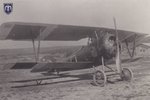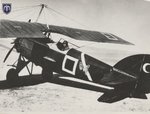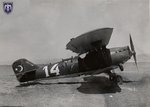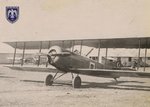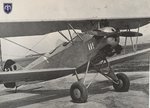- Thread starter
- #21
The Curtiss F11C Goshawk was a 1930s United States naval biplane fighter aircraft that saw limited success but was part of a long line of Curtiss Hawk airplanes built by the Curtiss Aeroplane and Motor Company for the American military. The only US Navy units to operate the F11C-2 were the Navy's famous "High Hat Squadron", VF-1B, aboard the USS Saratoga (CV-3), and VB-6 briefly assigned to USS Enterprise (CV-6). In March 1934 when the aircraft were redesignated BFC-2 the "High Hat Squadron" squadron was renumbered VB-2B, and then VB-3B, and retained its BFC-2s until February 1938. VB-6 never actually embarked on the Enterprise with the BFC bombers.
The F11C-2 Goshawk was produced in two export versions as the Hawk I and Hawk II fighters. Essentially a modified XF11C-2, the Hawk II was fitted with a Wright R-1820F-3 Cyclone rated at 710 hp at 1,676 m and 356 litres of fuel while the Hawk I had 189 litres of internal fuel. Both versions carried the same armament as the production F11C-2. Only the Hawk II was exported in quantity with Turkey, the first customer taking delivery of 19 on 30 August 1932.
TUAF purchased LGL-32 fighter planes from the French Firm Goudrou-Leuseurre in 1932. But since the French firm could not fill the obligations the contract was shifted to the US firm Curtiss. The new agreement covered the assembly of 24 Hawk-IIs, 7 Fledglings and 12 Fleets in Kayseri Aircraft Factory KTF. The first batch of 24 Hawk-IIs arrived with USAAC serials and they were assembled at the KTF. But later on 6 more Hawk-IIs were ordered but this time it was an under-licence production. In the meantime Hawk-IIIs were observed and they were very much appreciated by the authorities and a follow-on order of 40 Hawk-IIIs to be produced at the KAF was placed. The Hawks remained in service until 1945. The Hawk-II/IIIs were deployed at the 53th Fighter Co., 54th Figther Co. and at the Hava Okulu (aerial School).
The F11C-2 Goshawk was produced in two export versions as the Hawk I and Hawk II fighters. Essentially a modified XF11C-2, the Hawk II was fitted with a Wright R-1820F-3 Cyclone rated at 710 hp at 1,676 m and 356 litres of fuel while the Hawk I had 189 litres of internal fuel. Both versions carried the same armament as the production F11C-2. Only the Hawk II was exported in quantity with Turkey, the first customer taking delivery of 19 on 30 August 1932.
TUAF purchased LGL-32 fighter planes from the French Firm Goudrou-Leuseurre in 1932. But since the French firm could not fill the obligations the contract was shifted to the US firm Curtiss. The new agreement covered the assembly of 24 Hawk-IIs, 7 Fledglings and 12 Fleets in Kayseri Aircraft Factory KTF. The first batch of 24 Hawk-IIs arrived with USAAC serials and they were assembled at the KTF. But later on 6 more Hawk-IIs were ordered but this time it was an under-licence production. In the meantime Hawk-IIIs were observed and they were very much appreciated by the authorities and a follow-on order of 40 Hawk-IIIs to be produced at the KAF was placed. The Hawks remained in service until 1945. The Hawk-II/IIIs were deployed at the 53th Fighter Co., 54th Figther Co. and at the Hava Okulu (aerial School).
Attachments
Last edited:


